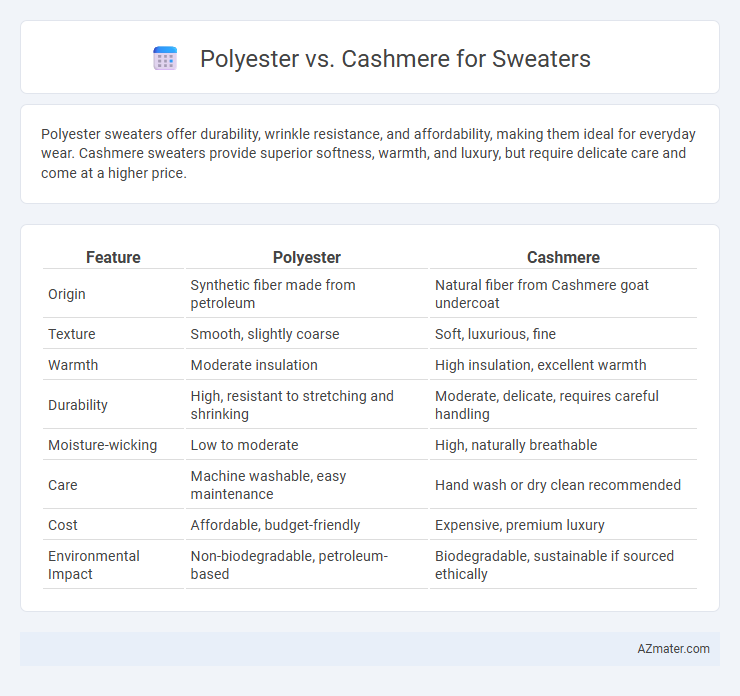Polyester sweaters offer durability, wrinkle resistance, and affordability, making them ideal for everyday wear. Cashmere sweaters provide superior softness, warmth, and luxury, but require delicate care and come at a higher price.
Table of Comparison
| Feature | Polyester | Cashmere |
|---|---|---|
| Origin | Synthetic fiber made from petroleum | Natural fiber from Cashmere goat undercoat |
| Texture | Smooth, slightly coarse | Soft, luxurious, fine |
| Warmth | Moderate insulation | High insulation, excellent warmth |
| Durability | High, resistant to stretching and shrinking | Moderate, delicate, requires careful handling |
| Moisture-wicking | Low to moderate | High, naturally breathable |
| Care | Machine washable, easy maintenance | Hand wash or dry clean recommended |
| Cost | Affordable, budget-friendly | Expensive, premium luxury |
| Environmental Impact | Non-biodegradable, petroleum-based | Biodegradable, sustainable if sourced ethically |
Introduction to Polyester and Cashmere Sweaters
Polyester sweaters offer durability, moisture resistance, and affordability, making them a popular choice for everyday wear. Cashmere sweaters, crafted from the fine undercoat of cashmere goats, provide superior softness, warmth, and luxury. Both fabrics present distinct advantages, with polyester excelling in ease of care and cashmere delivering unmatched comfort and elegance.
Material Origins: Polyester vs Cashmere
Polyester, a synthetic fiber derived from petroleum-based products, offers durability and resistance to wrinkles and shrinking, making it a cost-effective option for sweaters. Cashmere, sourced from the soft undercoat of cashmere goats primarily found in Mongolia and China, provides exceptional warmth, breathability, and a luxurious texture due to its natural protein fibers. The fundamental difference in material origins--petrochemical for polyester and natural animal fiber for cashmere--greatly influences the sweater's comfort, insulation, and environmental impact.
Softness and Comfort Comparison
Cashmere offers superior softness and luxurious comfort compared to polyester, thanks to its natural fine fibers that provide exceptional warmth and breathability. Polyester sweaters are generally less soft and can feel synthetic or coarse but offer durability and moisture-wicking properties. Ultimately, cashmere excels in providing a premium tactile experience, while polyester is favored for affordability and easy maintenance.
Warmth and Insulation Differences
Cashmere offers superior warmth and insulation compared to polyester due to its natural fibers that trap heat effectively while remaining lightweight and breathable. Polyester sweaters provide moderate insulation and are often less expensive, but they tend to retain less heat and can feel less comfortable in very cold conditions. The key difference lies in cashmere's ability to regulate temperature and wick moisture, making it ideal for optimal warmth in harsh weather.
Durability and Longevity
Polyester sweaters are highly durable, resistant to shrinking, stretching, and wrinkling, making them ideal for long-term wear and frequent washing. Cashmere offers superior softness and warmth but requires delicate care to maintain fiber integrity, as it is prone to pilling and wear over time. For maximum longevity, polyester outperforms cashmere in durability, while cashmere provides luxury and comfort with careful maintenance.
Care and Maintenance Requirements
Polyester sweaters require minimal care, often machine washable and resistant to wrinkles, shrinking, and stretching, making them easy to maintain. Cashmere sweaters need gentle hand washing or dry cleaning to preserve their softness and shape, with careful handling to avoid pilling and stretching. Proper storage in cool, dry places and use of moth repellents are essential for cashmere to extend its lifespan.
Environmental Impact and Sustainability
Polyester sweaters are derived from synthetic fibers made through petrochemical processes, resulting in high carbon emissions and non-biodegradable waste that contributes to microplastic pollution in oceans. Cashmere, sourced from the undercoat of cashmere goats, has a lower carbon footprint per garment but raises concerns over overgrazing and habitat degradation, threatening biodiversity. Sustainable sweater choices prioritize responsibly sourced cashmere with certification like the Sustainable Fibre Alliance, or recycled polyester blends to reduce environmental damage.
Price and Affordability
Polyester sweaters offer exceptional affordability, typically priced significantly lower than cashmere counterparts, making them accessible for budget-conscious shoppers. Cashmere sweaters command a premium price due to the labor-intensive harvesting and softness of the fiber, often costing several times more than polyester options. For consumers prioritizing cost-effectiveness, polyester provides durable warmth at a fraction of cashmere's expense.
Style and Versatility
Polyester sweaters offer a wide range of styles and vibrant colors, making them highly versatile for casual and sporty looks. Cashmere sweaters are synonymous with luxury and timeless elegance, providing a soft texture that elevates both formal and smart-casual outfits. While polyester is durable and easy to care for, cashmere stands out for its sophisticated drape and classic appeal in fashion.
Choosing the Best Sweater for Your Needs
Polyester sweaters offer durability, wrinkle resistance, and affordability, making them ideal for everyday wear and easy maintenance. Cashmere sweaters provide superior softness, warmth, and breathability, perfect for those seeking luxury and comfort in colder climates. Consider your budget, intended use, and preference for natural fabrics to choose the best sweater that balances style, comfort, and practicality.

Infographic: Polyester vs Cashmere for Sweater
 azmater.com
azmater.com